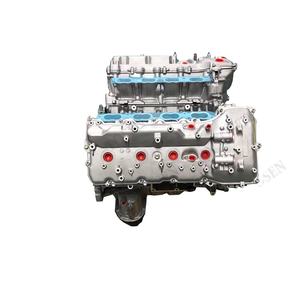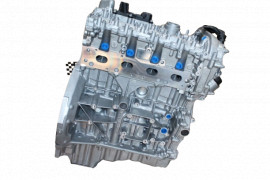Enhance Your Ride with a High-Quality Opel Corsa Engine
Enhance Your Ride with a High-Quality Opel Corsa Engine
Blog Article
Exploring the Inner Functions of a Compact Lorry's Engine System
As chauffeurs, we commonly take for provided the elaborate processes that take place within the boundaries of our vehicle's engine system. In this expedition of a compact lorry's engine system, we will certainly decipher the inner workings of this mechanical symphony, dropping light on the secrets that drive us forward on our day-to-day trips.
Burning Process Summary
The burning procedure in a compact car's engine system is an essential mechanism that successfully transforms fuel into power to power the car. This process takes place within the burning chamber of the engine, where gas and air mix, spark, and create controlled explosions. The combustion process includes four main phases: consumption, power, exhaust, and compression.
Throughout the consumption stage, the piston moves downward, attracting in a mix of air and fuel into the combustion chamber. This down activity generates the power needed to drive the car. This cyclic burning process is fundamental to the operation of a portable car's engine system, making sure reliable power conversion for propulsion.
Piston and Cylinder Interaction

The piston's accurate fit within the cyndrical tube is necessary for keeping optimum compression and preventing energy loss during combustion. Tight clearances between the piston and cylinder walls guarantee efficient sealing, allowing the piston to move smoothly without allowing gases to leakage past. Correct lubrication is additionally essential to lower rubbing and use in between these elements, improving longevity and performance.
Furthermore, the layout and products made use of in producing the piston and cylinder impact engine efficiency and durability. Modern engines often use light-weight yet long lasting materials like aluminum alloys for pistons and cyndrical tube linings to decrease inertia and enhance thermal performance. Overall, the unified interaction between the piston and cyndrical tube is essential to the engine's functionality and total efficiency.
Fuel Shot System Performance
Fuel shot systems in small vehicle engines play a critical duty in exactly supplying fuel to the combustion chamber for regulated and efficient ignition. The gas injection system functions by infusing fuel right into the combustion chamber at the ideal moment throughout the engine's operation (opel corsa engine). This specific timing makes sure that the fuel blends evenly with the air for correct combustion, bring about enhanced gas effectiveness and lowered discharges
There are primarily two kinds of gas injection systems made use of in compact lorry engines: port fuel shot (PFI) and direct fuel shot (DFI) PFI systems inject gas into the consumption port prior to the intake shutoff, while DFI systems inject fuel straight right into the burning chamber. Both systems have their benefits, with DFI providing far better fuel atomization and PFI supplying an extra affordable solution.
Comprehending Engine Cooling Systems
Efficient operation of a small lorry's engine depends greatly on the effectiveness of its cooling systems. Engine air conditioning is vital to avoid getting too hot, which can lead to major damages and lowered efficiency. The cooling system in a small automobile typically contains a number of elements collaborating to manage the engine temperature level. One essential component is the radiator, which uses coolant to absorb warm from the engine. As the warm coolant moves via the radiator, it launches warm into the air, cooling down before returning to the engine. The water pump distributes the coolant via the engine and radiator, making certain Visit Your URL a consistent flow to regulate temperature. Furthermore, the thermostat assists manage the coolant circulation to preserve ideal engine temperature. Some vehicles also have cooling fans that turn on when added air conditioning is required, such as during hefty web traffic or heat. Recognizing these engine air conditioning mechanisms is essential for keeping the efficiency and durability of a compact lorry's engine system.

Exhaust System Elements Explained
The optimal functioning of a portable automobile's engine this cooling systems depends on a complementary system understood as the exhaust system, which consists of numerous important parts for guaranteeing reliable emissions and engine performance. The exhaust manifold accumulates exhaust gases from the engine's cylinders and paths them to the catalytic converter.
One vital component of the exhaust system is the oxygen sensor, which checks the oxygen degrees in the exhaust gases to help regulate fuel intake and guarantee optimal engine performance. opel corsa engine. Additionally, the resonator might exist in some exhaust systems to reduce noise degrees. On the whole, the exhaust system plays a vital function in maintaining engine performance, reducing damaging exhausts, and ensuring a quieter driving experience for More Bonuses small car owners

Final Thought
To conclude, the compact car's engine system is a complex combination of components that interact to promote the combustion process, convert fuel right into power, and eliminate waste gases. Understanding the internal operations of the engine system, including the piston and cylinder interaction, fuel shot system, engine cooling mechanisms, and exhaust system components, is vital for keeping optimum efficiency and performance of the car.
The burning procedure in a small automobile's engine system is a critical device that effectively transforms fuel into energy to power the car.Fuel injection systems in compact car engines play a vital function in exactly providing fuel to the combustion chamber for efficient and controlled ignition.There are largely two kinds of gas injection systems used in compact vehicle engines: port gas shot (PFI) and direct fuel injection (DFI) Comprehending these engine cooling mechanisms is essential for keeping the efficiency and durability of a compact vehicle's engine system.
The optimum performance of a small vehicle's engine air conditioning devices depends on a corresponding system understood as the exhaust system, which comprises numerous crucial elements for guaranteeing efficient discharges and engine performance.
Report this page